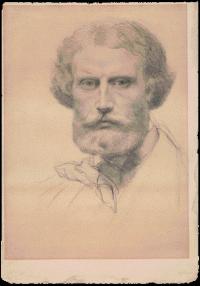The artist
Published in 18th–19th - Century History, Features, Issue 5 (Sept/Oct 2012), Volume 20
Burton’s self-portrait in pencil c. 1845, showing the young painter’s handsome features, intelligence and distinction of manner. He was 58 when Gladstone appointed him director of the National Gallery, London, in 1874. (National Gallery of Ireland)
Frederic William Burton was born in 1816 in Corofin, Co. Clare, the third son of an amateur landscape painter. The family moved to Dublin, where in 1826 Burton attended the Dublin Society Schools, starting out as a painter of miniatures and portraits. He mixed in antiquarian circles that included George Petrie, Samuel Ferguson, Eugene O’Curry, William Wilde and William Stokes. The Aran fisherman’s drowned child (1841) is a key work of this period. He exhibited at the Royal Hibernian Academy and the Royal Academy, London, travelling and painting in Germany (1851–7) and returning frequently to Ireland. In 1858 he established himself in London as a painter of portraits and subject pictures, mixing in Pre-Raphaelite circles but not a member of the movement.The meeting on the turret stairs, executed when he was at the height of his career, has been popular since first exhibited at the Old Watercolour Society’s Annual Exhibition in London (1864), and at the Dublin International Exhibition of Arts and Manufactures in 1865. In the words of writer and poet George Eliot (Mary Anne Cross, née Evans): ‘The subject might have been made the most vulgar thing in the world—the artist has raised it to the highest pitch of refined emotion’ (G.S. Haight (ed.), The George Eliot letters (9 vols, 1954–78), vol. 4, 147). Burton’s portrait of Eliot (1865) is in the National Portrait Gallery, London. The meeting on the turret stairs was in a number of private collections before being purchased in 1898 by Whitley’s sister, Margaret McNair Stokes (1832–1900), an archaeologist and art historian friend of Burton, who gave her copyright for the watercolour. Her bequest to the National Gallery of Ireland (1900) included this painting.Burton was an erudite figure, well travelled and familiar with all the major European museums. When he was appointed director of the National Gallery, London (1874–94), he ceased painting. The new director oversaw building extensions, catalogued the collection and acquired over 500 paintings, including Leonardo’s Virgin of the Rocks, for the Gallery. In 1884 he was knighted, and in 1889 received an honorary conferring from Trinity College, Dublin. Following his death in March 1900 in London, he was buried at Mount Jerome Cemetery, Dublin.
















